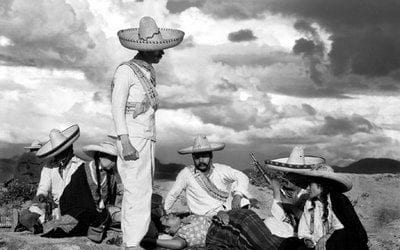The View from Texas

Strolling on the Texas border.
The elections of President George W. Bush and Mexican President Vicente Fox have created an unprecedented opportunity along the 2000-mile-long U.S.-Mexico border. Since the inception of NAFTA in 1994, the border region has shown a noticeable increase in jobs and earned income. Now, private and public sectors have begun to reassess the challenges facing the border to continue that growth. Among their top priorities are economic development, education, and technology.
The border is not a foreign place to me; I crossed it every day during my childhood to go to school. However, it wasn’t until this summer that I realized the enormous potential behind the border. As an intern at Imbran, a real estate development firm in Tamaulipas, I had a first-hand look into the future of the border.
One of the events I attended while in Tamaulipas was the US-Mexico Border Governors Conference in Tampico. The conference featured the governors of all nine US and Mexican border states. All of the speakers presented individual objectives for the border, but there appeared to be one common goal: economic growth.
Since the 1994 North American Free Trade Agreement, Mexico’s export business has been booming. This year, Mexico is expected to pass Japan as the second-largest supplier of foreign-made goods to the United States, with more than $120 billion in exports moving across the border. Exports account for nearly one-third of Mexico’s $500 billion economy and at least half of the three million jobs created since NAFTA took hold. Overall, the value of Mexico’s exports has risen from $61 billion in 1994 to an estimated $165 billion this year more than the combined exports of all South American countries.
The maquiladora industry has been a large contributor to this growth. As corporations face greater competition, the demand for a skilled but more competitively priced workforce has increased. Mexican labor is sought out for its high quality and low cost. Most maquiladora workers get paid anywhere from one to two U.S. dollars per hour in Mexico, compared to an average rate of 12 to 15 USD in the US. When you consider that most factories have about 100 employees, on average that amounts to an additional $1000 per hour, $40,000 per week, and $2,000,000 per year. With the recent slowdown in the US economy, these numbers may begin to lure more corporations across the border.
Maquiladora exports are growing three times faster than the GDP’s growth rate and the industry accounts for 18% of new jobs nationwide. Consistent increases in workforce productivity since the 1970’s have attracted higher technology industries to Mexico. In fact, 60 % of the maquiladora industry is located on the border with the United States. Tamaulipas is geographically positioned to capitalize on the industry’s growth. However, the rapid growth within the maquiladora industry has made it increasingly difficult to find available land sites with the necessary infrastructure required by the high-technology industry, says Matamoros mayor, Homar Zamorano. Reynosa and Matamoros in Mexico have been growing at explosive rates, causing stress on the citizens, the infrastructure, and the environment. A new master-planned city may be a solution to provide adequate space and services.
One such project is underway on the Texas-Tamaulipas border. The location is sometimes called the “Texas Tropics,” because the balmy Rio Grande Valley is a popular tourist destination. But it’s what’s on the other side of the Rio Grande that interests corporations the most. Labor availability at reasonable cost, strategic location for distribution, and land availability have prompted companies around the world to view Mexico as an attractive alternative in their relocation decisions.
Impulsora Industrial los Indios, also known as I3, has plans to create a master-planned community by the name of Lucio Blanco. As with other industrial parks, Lucio Blanco will allow companies to manufacture in Mexico using inputs from the U.S. at no extra cost. The project is unique because it will concentrate on “smarts” rather than smokestacks. We want to push the maquiladoras into the 21st century by moving away from the traditional textile and furniture industries and toward the high-technology companies in the computer software, microelectronics, and biomedical industries,” says I3 executive Juan Carlos Montalvo, adding that the company wishes to concentrate new ventures Silicon Valley-style to stimulate self-sustained growth. In fair disclosure, another of the founders of the project is Ramón H. Sampayo, my father.
Because of the family connection but, in particular, as a result of my internship, I’ve come to see technology as the key to economic growth. However, new technopolises have grown too fast in recent years, causing spiraling real estate prices and rampant air and water pollution. A regional solution is needed to address the growing demands required to attract, develop, and sustain technology industries in the South Texas/Northeastern Mexico Border Region. Jorge Reyes Moreno, secretary of economic development for the state of Tamaulipas, observes that planned communities “will do away with many of the unexpected problems that cities, such as Matamoros and Reynosa, face due to the recent growth in border cities.
Education was another primary concern at the Border Governors Conference. The border needs more than just manual labor; it needs educated labor, so education and training must be prioritized before growth companies commit to projects similar to Lucio Blanco. Texas Governor Rick Perry has appointed a special commission to examine such issues as accessible and affordable higher education, the integration of technology into the college experience, and meeting the evolving workforce needs of Texas. Plans are already underway to train students for technology-oriented jobs. The governor says he is determined to continue reform in public schools, increasing attention to the critical fields of math and science.
In addition, regional studies are being made by the IC2 Institute from the University of Texas at Austin as part of the Cross Border Institute for Regional Development (CBIRD) project. Created by the Instituto Tecnologico de Estudios Superiores de Monterrey (ITESM), the University of Texas (Austin & Brownsville), and the Houston Advanced Research Center (HARC), CBIRD seeks to prepare a highly trained labor force to attract and sustain high-tech industries in the border region. Together, I3 and CBIRD aim to prepare students through advanced educational facilities and work closely with all sectors of the border economy to satisfy workforce needs.
Telecommunications infrastructure seems to be the final step for the border. Tamaulipas governor Tomas Yarrington pointed out the importance of technological improvement in the advancement of the border economy. With the help of Governor Perry, both states are committed to making sure that the Texas-Tamaulipas region is at the forefront of the digital revolution. Officials are already working on landing DSL lines and fiberoptic cabling in the Rio Grande Valley and across the Rio Grande into Matamoros and Lucio Blanco. In addition, the United States-Mexico Chamber of Commerce (USMCOC) has already implemented its Wiring the Border project to increase sustainable economic development along the U.S.-Mexico Border. The project will create a virtual network from San Diego/Tijuana to Brownsville/Matamoros connected with Electronic Commerce Research Centers or Nodes. USMCOC is working with IBM, Telmex, CompUSA/Prodigy, Roadway, GE, Globe-1, Boeing, Delphi, To2.com and Banorte to assure the success of the project.
As an intern here in Matamoros, it seems to me that the U.S.-Mexico border is one of the most dynamic regions of the world. Both countries have come a long way as independent nations; there is no telling what they can accomplish together.
Fall 2001, Volume I, Number 1
Patricio Sampayo is a Harvard University economics concentrator with a special interest in Latin America; he received a DRCLAS internship this past summer to work with Imbran, a real estate development firm that concentrates on promotion, sales, and marketing services. Sampayo, who lived in Mexico for 18 years prior to leaving for college, crossed the U.S.-Mexico Border daily to attend grade school and high school. He can be reached at.
Related Articles
Updates: Harvard’s Latin@ Community
As a recent Harvard College graduate and active Latin@ student leader, one would think that an article on “the history of the Latin@ community at Harvard” would be a breeze. However, as I…
On Observing Elections and Magistrates’ Faces
Where votes were traded just last year for brand new bicycles and sewing machines, the 2001 offering price in Yucatán State’s May gubernatorial election was rumored to be a pitcher of beer…
A New Golden Age for the Silver Screen
Mexican movies are terrible, don’t watch them, the taxi driver told me when I first arrived in Mexico City last summer. Mexican movies are terrible, and also tasteless, reaffirmed my Spanish…




